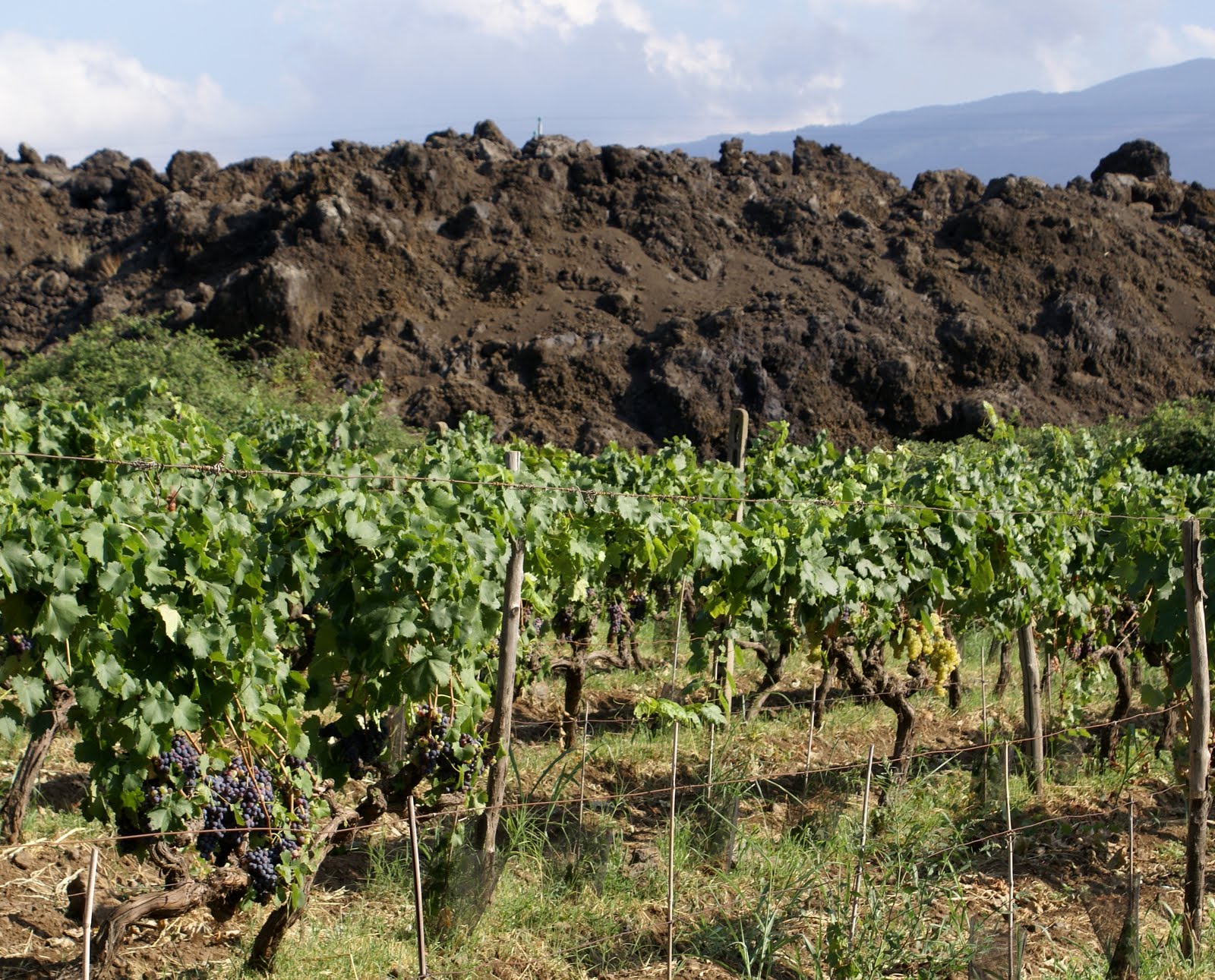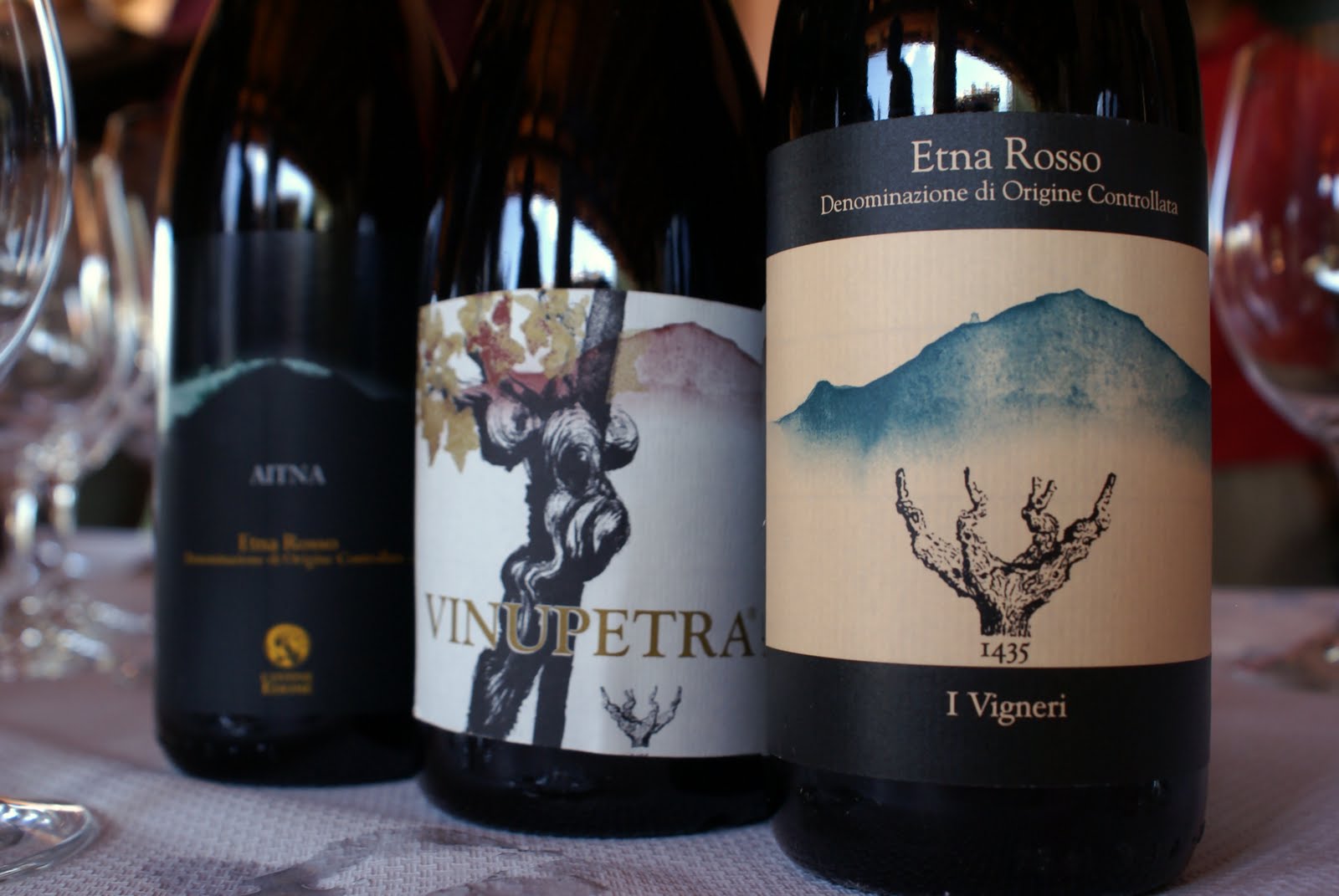On the Etna (3)
Posted on 9 September 2009
Salvo Foti.
My last day on the Etna was a vineyard tour guided by Salvo Foti, a leading local viticulturalist and winemaker. Foti is consulting for some large wineries such as Benanti but is today dedicating himself chiefly to the I Vigneri project. Named after a ‘vintners’ guild’ founded in 1435, it’s an association of small estates from the Etna and some other zones in Sicily that are all cultivating bush vine (alberello) vineyards under the guidance of Foti.
We had a look at some of these vineyards in two of Etna’s distinctive vine-growing district: the eastern and northern slope. The former has a mild, maritime, fairly humid climate (precipitation is 1500–2000 mm annually, which is quite a bit), resulting in red wines that are a little lighter and fruitier; this is also the source for most of Etna’s distinctive, mineral, salt-scented white wine (mostly based on the local Carricante grape). We saw a vineyard of Mick Hucknall’s Il Cantante estate. Bush vines are planted very densely (10K vines / ha), trained on a single pole; most are terraced (few vineyards on the Etna are planted directly on slopes). Eastern Etna is a very green landscape, and if ‘biodiversity’ sounds nice to you, you’ll find plenty here: vines alternate with olive, citrus, peach, fig, hazelnut and almond trees, and lots of chestnuts (we saw a 1700-year-old example).
Palmento: step in to foot-tread the grapes here.
Il Cantante also have a nicely restored palmento, the typical winemaking structure of the 19th century when Etna was producing no less than 100m liters of wine (most of that period’s Barolo and Brunello was in fact blended with wines from the South, Etna included). Palmento is a ground floor vinification building with stone basins for foot treading, similar to the lagares of Portugal. By gravity, foot-trodden musts would pour into fermentation basins on the lower floor. Palmenti often have no cellar: the wine being shipped in the spring season following the harvest, there was never need to keep any in cask or bottle.
La Fruttiera vineyard in northern Etna, surrounded by lava outcrops.
It’s roughly a 45-minute drive on a scenic road, perched at 800m of altitude, to reach to northern slope of the Etna, where most vineyards are now concentrated in the towns of Castiglione, Linguaglossa and Randazzo. It’s quite a dramatic change in climate. Sheltered from Mediterranean influences by the Nebrodi mountain range to the north, these vineyards only see some 600mm of rain per year, and the temperature differences between day and night can reach 30C. The grape maturation period is extended, and with vineyards at 800–1100m above sea level, the harvest often takes place in late November – the latest of any Mediterranean region. Here, red wines reign supreme, with the Nerello Mascalese grape reaching qualitative heights. The wines have high acidity and fierce tannins and are apt for long ageing. Vineyards are also much older: we saw a 1-hectare parcel of 130-year-old vines, partly ungrafted: phylloxera cannot survive on the very active volcanic ash sand.
The landscape of northern Etna is very different from the flamboyant vegetation of the east. There are huge lavic outcrops everywhere, and most of the land is covered by scrub and cacti. We saw a spectacular vineyard east of Randazzo named La Fruttiera (belonging to the Tenute Romeo del Castello on which I reported yesterday) which was menaced by an Etna eruption in 1981. In the end, the lava deviated just meters from the vines, and can now be seen in the shape of a 3-meter-high wall of black stone. Scary.
The wines of Salvo Foti all share a distinctive style. They are fairly punchy with abrasive, somewhat overextracted tannins, which I felt were not supported by sufficient fruit. The yields of some bush vines we saw were surely looking excessive (typically a dozen bunches per vine, totalling an estimate of 3–3.5kg of grapes) but Foti said the vines are sturdy and can manage that. On the positive side, the wines show little or no oak and have the obvious mineral personality you expect from an Etna red. We tasted a red called Aitna from the Edomè estate: the 2005 is suffering from a bit of brett but is showing opulent fruit too; the 2006 is better, more floral on the nose, tannic and a little simple but characterful. Salvo Foti’s own label is called I Vigneri: the Etna Rosso 2005 is tonic, juicy and driven with not masses of body, the 2006 again a bit more convincing but the tannins are fiercely drying; this will need 3 or 4 years in the bottle. Then there are two special bottlings: Vinudilice 2008 is a curious rosé made from co-pressed red and white grapes from the 130-year-old vineyard at 1300m above sea level. Unsulphured with high malic acid and some 10g residual sugar, it’s wild stuff, with a touch of vegetal, foxy character to the nose and a rustic, mineral palate that I found a little raw – but many of my journo colleagues seemed to like it quite a bit. Vinupetra is Foti’s top label in red. Clearly the best wine we tasted on the day, the 2005 is floral and cherryish with some fruit sweetness on the nose, coupled with Etna’s distinctive spice. Lots of presence on the palate, still a little overtannic and rigid as per the Foti style but shows good natural concentration and expression of fruit. The 2006 is similar with perhaps a bit more harmony. Vinupetra is a good example of a mineral, unoaky Etna red with lots of potential.





